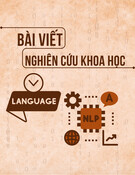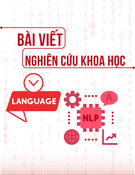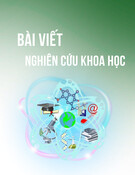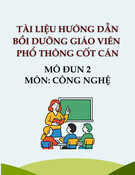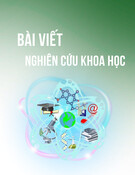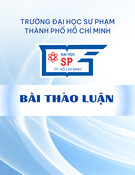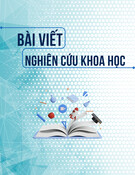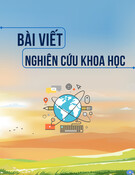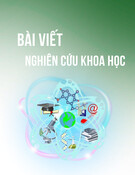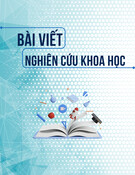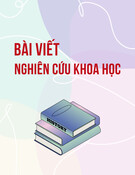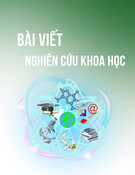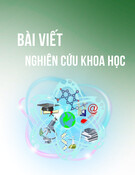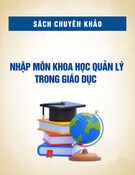
5056
Factor Influencing Students’ Scientific Literacy: An
Exploratory Factor Analysis
Mohd Radzi Abu Bakar, Lilia Halim, Nurazidawati Mohamad
Arsad
Faculty of Education, Universiti Kebangsaan Malaysia, 43600 Bangi, Selangor Darul
Ehsan, Malaysia
Email: azidarsad@ukm.edu.my
Abstract
Knowing what influences students' ability to understand and apply science in their daily lives
will help with intervention planning and better understanding of the factors that influence
students' scientific literacy. Thus, this study aimed to develop an instrument to identify
factors contributing to students’ scientific literacy. Four phases were employed to develop
the instrument: conduct content validity, administer a pre-test, conduct construct validity
using exploratory factor analysis, and determine construct reliability. A 131-item
questionnaire was administered to 350 form four students aged 16 years old in daily
government schools. Three constructs were subjected to exploratory factor analysis: the
constructivist learning environment (CLE), attitude toward science (ATS), motivation, and
self-efficacy (MSE). The five subconstructs of CLE are personal relevance, uncertainty,
critical voice, shared control, and student negotiation. ATS comprises of seven
subconstructs: social implications of science, normality of scientists, attitude to scientific
inquiry, adoption of scientific attitudes, enjoyment of science lessons, leisure interest in
science, and career interest in science. Finally, MSE consists of three subconstructs: intrinsic
motivation, extrinsic motivation, and self-efficacy. The instrument is expected to be useful
in research and evaluation to measure factors influencing students' scientific literacy.
Keywords: Attitude, Motivation, Scientific Literacy, Factor Analysis
Introduction
A scientific literate person is someone who can understand, apply, and be involved
with issues, problems or arguments related to science and technology (OECD, 2016).
Acquiring scientific literacy reflects students’ ability to solve everyday problems at the
individual and community levels scientifically (Fives et al., 2014; Choi et al., 2011).
Students’ achievement in scientific literacy, measured through Trends in International
Mathematics and Science Study (TIMSS) dan Programme for International Student
Assessment (PISA), acts as a benchmark to a country's achievement and effectiveness in
Vol 13, Issue 12, (2023) E-ISSN: 2222-6990
To Link this Article: http://dx.doi.org/10.6007/IJARBSS/v13-i12/20393 DOI:10.6007/IJARBSS/v13-i12/20393
Published Date: 26 December 2023

INTERNATIONAL JOURNAL OF ACADEMIC RESEARCH IN BUSINESS AND SOCIAL SCIENCES
Vol. 13, No. 12, 2023, E-ISSN: 2222-6990 © 2023
5057
delivering the country's science education (MOE, 2013) against the other countries that
participate in the international assessments. Malaysia participated in 1999, and Malaysia’s
ranking was above the international score in Mathematics and Science. However, Malaysia's
participation in the latest TIMSS in 2015 saw that the performance of Malaysian students
increased slightly compared to the previous year after two declines in 2007 and 2011.
Malaysia began participating in the PISA international examination in 2009. PISA
assessed 74 countries and, once again, Malaysia's performance is dismal, ranking Malaysia
in the bottom one-third of all participating countries. Malaysia's performance likewise falls
short of the global and OECD averages. Malaysian students' science performance in PISA
2015 and 2018 improved slightly but remained below the OECD average (MOE, 2013; IEA,
2000, 2004, 2008, 2012, 2016).
Factors Influencing Students’ Scientific Literacy
Factor 1: Science Knowledge. Science knowledge is a cognitive component
emphasised while educating pupils to be scientifically literate (Halim, 2009 & Olubu 2015).
According to the OECD (2018), scientific knowledge refers to the fundamental scientific
concepts necessary for comprehending natural occurrences and the changes in nature
caused by human activity. It encompasses both knowledge of science (knowledge of
nature) and knowledge about science (knowledge of scientific processes). Scientific
knowledge also includes the physical, biological, and chemical sciences and technology.
Understanding the scientific process establishes the primary foundation for scientific
inquiry. It entails the relevance of scientific theory, scientific investigation, quantitative
and qualitative data measurement, and systematic steps for empirically and tentatively
establishing evidence. Scientific knowledge is then created through scientific explanation,
which involves presenting, arguing for, and generating new knowledge, methods, and
concepts based on the data from scientific studies. Because it incorporates practical or
hands-on science activities and experiments, the constructivist science laboratory
learning environment is considered capable of developing students' scientific inquiry.
According to Hofstein et al. (2004) and Moeed (2015), when these experiments or
laboratory activities are designed effectively, the learning experience received by
students can potentially improve their comprehension and knowledge of science, hence
increasing students' scientific literacy.
Factor 2: Constructivist Learning Environment. The learning environment
substantially impacts students' ability to enhance their scientific literacy (Techakosit &
Wannapiroon, 2015). Students' roles have shifted in constructivist learning contexts, such
as in science labs and 21st-century conceptual classrooms, from just receiving knowledge
to building knowledge with the support of teachers (Halim, 2009 & Terhart, 2003). This
learning environment teaches students to collaborate, take on various roles, advocate for
ideas, and participate in decision-making. Teachers have a responsibility to conduct
student-centred activities that will boost students' learning processes, develop their
ability and critical thinking skills, and in turn, will improve their achievement (Terhart,
2003 & Bay et al., 2012). A constructivist learning environment produces active students
who can plan effectively, solve issues, critique, and create practical connections in their
daily lives (Terhart, 2003; Bay et a., 2012).

INTERNATIONAL JOURNAL OF ACADEMIC RESEARCH IN BUSINESS AND SOCIAL SCIENCES
Vol. 13, No. 12, 2023, E-ISSN: 2222-6990 © 2023
5058
Factor 3: Attitudes Toward Science. Attitude is one of the factors influencing
scientific literacy and the learning environment (Chionh & Fraser, 2009). According to
Ajzen (2012), attitude plays a significant role in determining human behaviour. Most
studies on scientific learning settings have discovered a correlation between science
learning environments and attitudes toward science (Wahyudi & David, 2004; Telli et al.,
2006). Students' attitudes toward science reflect their 'affective behaviours, including
their acceptance, appreciation, and devotion to science. Research has established that the
learning environment is a significant predictor of students' attitudes toward science
(Aldoplhe et al., 2003; Karpudewan & Chong, 2017). Attitudes towards science are
essential when considering scientific literacy (Bybee & McCrae, 2011). This attitude
encompasses knowledge, emotion, and propensity for action. This component affects
students' continuous interest in science and issues relating to science (Bybee & McCrae,
2011). Scientific literacy was the primary domain examined in the PISA 2009 assessment,
and the assessment's definition of scientific literacy included features of individual
attitudes toward science (OECD, 2010). However, research examining scientific literacy
place a lesser emphasis on the attitude component as a primary component.
Factor 4: Motivation and Self-Efficacy. Research has also stressed the critical
relationship between students' learning settings, science literacy, and motivation (Jackson
& Davis, 2000; Aldridge et al., 2013). Motivation is a mental process that directs pupils'
choices, efforts, and persistence. According to Pintrich & Schunk (2002), the learning
environment provides students with a variety of options and loci of control to increase
intrinsic motivation, increased levels of self-efficacy, goal orientation, and other types of
motivation. Bandura's social cognitive theory of self-efficacy explains that students will
take greater initiative to learn science if they can attain the required objectives (Bandura,
1986). Students who have a high sense of self-efficacy are more likely to exert
considerable effort on a given task, monitor its progress, and employ self-regulation
mechanisms (Schunk & Pajares, 2005). Students who appreciate science had a greater
chance of achieving favourable learning outcomes and subsequent high results on
scientific literacy examinations (McNeil, 2013) Additionally, studies demonstrate that
groups of students who exhibit strong emotions toward science learning, such as
enthusiasm, enjoyment, and involvement, achieve high levels of scientific literacy (Topcu
et al., 2016).
Thus, this study aims to develop a questionnaire on factors that influence students'
scientific literacy based on three primary constructs, namely constructivist learning
environment (CLE), attitude toward science (ATS), motivation, and self-efficacy (MSE). At
the same time, test questions will be used to measure constructs; science knowledge (SK)
and scientific literacy (SL).
Method
In this study, the construction of the instrument of factors influencing students ’scientific
literacy is based on the following four steps:
Phase 1: Conduct content validity
Phase 2: Administer a pre-test
Phase 3: Use exploratory factor analysis for construct validity
Phase 4: Determine construct reliability

INTERNATIONAL JOURNAL OF ACADEMIC RESEARCH IN BUSINESS AND SOCIAL SCIENCES
Vol. 13, No. 12, 2023, E-ISSN: 2222-6990 © 2023
5059
Research Context
350 form four students from daily government schools aged 16 years old were
randomly selected. The sample involved ten schools in the state of Johor, and they had
characteristics that were very similar to the actual study population. Table 1 shows the
distribution of the respondents.
Table 1.
Respondents’ Background
Background
N
%
Gender
Male
136
38.9
Female
214
61.1
Malay
264
75.4
Chinese
75
21.4
Race
Indian
10
2.9
Other
1
0.3
Type of class
Science
201
57.4
Art
149
42.6
Science
subject grade
in national
(PT3)
examination
A
65
18.6
B
73
20.9
C
77
22.0
D
122
34.9
E
10
2.9
F
3
0.9
Instrument Development
Phase 1: Conduct Content Validity
Questionnaires will be used to measure construct constructivist learning
environment (CLE), attitude toward science (ATS), motivation, and self-efficacy (MSE). In
contrast, test questions will measure construct science knowledge (SK) and scientific
literacy (SL).
Expert validity was conducted, with a lecturer from MOHE and two science
educators from MOE serving as experts in science education. These experts verified the
content of each item. They also verified the instrument's accuracy in terms of language
and terminology, as it was adapted from the original survey and translated from English
to Malay. Table 2 summarises the constructs examined in this study. study.

INTERNATIONAL JOURNAL OF ACADEMIC RESEARCH IN BUSINESS AND SOCIAL SCIENCES
Vol. 13, No. 12, 2023, E-ISSN: 2222-6990 © 2023
5060
Table 2
Construct, Subconstruct And Examples Of Items In The Questionnaire
Adaptation
Sources
Subconstruct
No. of
item
Example of items
Constructivist Learning Environment (CLE)
Constructivist
Learning
Environment
Survey (CLES)
Taylor & Fraser
(1991)
Personal
Relevance
6
• My new learning starts with problems
about the world outside of school.
Uncertainty
6
• I learn that science cannot provide
perfect answers to a problem.
Critical Voice
6
• It is OK for me to ask the teacher why I
have to learn this?
Shared
Control
6
• I help the teacher to plan what I'm
going to learn.
Student
Negotiation
6
• I explain my understandings to other
students
Attitude Toward Science (ATS)
Test of Science
Related
Attitude
(TOSRA)
Fraser (1981);
Kamisah,
Zanaton & Lilia
(2007)
Social
implications of
science
10
• Scientific discoveries are doing more
good than harm.
Normality of
scientists
10
• Scientists do have enough time to
spend with their families.
Attitude to
scientific
inquiry
10
• Doing experiments is more good than
finding out information from teachers.
Adoption of
scientific
attitudes
10
• I like repeating experiments to check
that I get the same results.
Enjoyment of
science
lessons
10
• I would like to belong to a science club.
Leisure
interest in
science
10
• Science lessons are fun.
Career
interest in
science
10
• I would like to be a scientist after I leave
school.
Motivation and Self Efficacy (MSE)
Motivated
Strategies for
Learning
Questionnaire
(MSLQ)
Pintrich, Smith,
Garcia &
McKeachie
(1991)
Intrinsic
motivation
14
• In a class like this, I prefer course
material that really challenges me so I
can learn new things.
Extrinsic
motivation
9
• Getting a good grade in this class is the
most satisfying thing for me right now.
Self-efficacy
8
• I'm confident I can learn the basic
concepts taught in this course.

